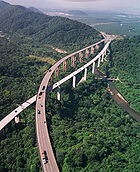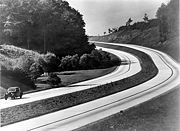
Highway engineering
Encyclopedia

Civil engineering
Civil engineering is a professional engineering discipline that deals with the design, construction, and maintenance of the physical and naturally built environment, including works like roads, bridges, canals, dams, and buildings...
which involves the design, construction and maintenance of Highway Systems. Highway Engineering become prominent towards the latter half of the 20th Century after World War 2. Standards of highway engineering
Engineering
Engineering is the discipline, art, skill and profession of acquiring and applying scientific, mathematical, economic, social, and practical knowledge, in order to design and build structures, machines, devices, systems, materials and processes that safely realize improvements to the lives of...
are continuously being improved. Highway Engineers must take into account future traffic flows, design of highway intersections/interchanges, geometric alignment and design, highway pavement materials and design, structural design of pavement thickness, and pavement maintenance.
Most developed nations have extensive highway networks.

History of Highway Engineering
The beginning of road construction could be dated back to when the Romans were around. With the advancement of technology from carriages pulled by two horses to vehicles with power equivalent to 100 horses, road development had to follow suit. The construction of modern highways did not begin until the late 19th to early 20th century.The first research dedicated to highway engineering was initiated in the United Kingdom with the introduction of the Transport Research Laboratory
Transport Research Laboratory
TRL is a British transport consultancy and research organisation based at Wokingham Berkshire with approximately 500 staff. TRL is owned by the Transport Research Foundation , which is overseen by 80 sector members from the transport industry. TRL also own small UK regional offices situated in...
(TRL), in 1930. In the USA, highway engineering became an important discipline with the passing of the Federal Aid Highway Act of 1944, which aimed to connect 90% of cities with a population of 50,000 or more. With constant stress from vehicles which grew larger as time passed, improvements to pavement were needed. With technology out of date, in 1958 the construction of the first motorway in Great Britain (the Preston bypass) played a major role in the development of new pavement technology.
Design policies standards used in the United States
United States
The United States of America is a federal constitutional republic comprising fifty states and a federal district...
are typically based on publications of the American Association of State Highway and Transportation Officials
American Association of State Highway and Transportation Officials
AASHTO, the American Association of State Highway and Transportation Officials, is a standards setting body which publishes specifications, test protocols and guidelines which are used in highway design and construction throughout the United States...
as well as research promulgated by the Transportation Research Board
Transportation Research Board
The Transportation Research Board is a division of the National Research Council, which serves as an independent adviser to the President, the Congress and federal agencies on scientific and technical questions of national importance...
, the Institute of Transportation Engineers
Institute of Transportation Engineers
The Institute of Transportation Engineers or ITE is an international educational and scientific association of transportation professionals who are responsible for meeting mobility and safety needs. ITE was founded in 1930 as the Institute of Traffic Engineers and its first president was Ernest P...
, the Federal Highway Administration
Federal Highway Administration
The Federal Highway Administration is a division of the United States Department of Transportation that specializes in highway transportation. The agency's major activities are grouped into two "programs," the Federal-aid Highway Program and the Federal Lands Highway Program...
, and the Department of Transportation
United States Department of Transportation
The United States Department of Transportation is a federal Cabinet department of the United States government concerned with transportation. It was established by an act of Congress on October 15, 1966, and began operation on April 1, 1967...
.
Highway and parkway
- Controlled-access highwayControlled-access highwayA controlled-access highway is a highway designed exclusively for high-speed vehicular traffic, with all traffic flow and ingress/egress regulated...
- Interstate Highway SystemInterstate Highway SystemThe Dwight D. Eisenhower National System of Interstate and Defense Highways, , is a network of limited-access roads including freeways, highways, and expressways forming part of the National Highway System of the United States of America...
- Limited-access highway
- ParkwayParkwayThe term parkway has several distinct principal meanings and numerous synonyms around the world, for either a type of landscaped area or a type of road.Type of landscaped area:...
- Strategic Highway Network
Design and consideration
- Degree of curvatureDegree of curvatureDegree of curve or degree of curvature is a measure of curvature of a circular arc used in civil engineering for its easy use in layout surveying....
- Geometric design of roadsGeometric design of roadsThe geometric design of roadways deals with the positioning of the physical elements of the roadway according to standards and constraints. The basic objective in geometric design is to provide a smooth-flowing, crash-free facility. Geometric roadway design can be broken into three main parts:...
- Pavement engineeringPavement engineeringPavement engineering is a branch of civil engineering that uses engineering techniques to design and maintain flexible and rigid pavements. This includes streets and highways and involves knowledge of soils, hydraulics, and material properties. Pavement engineering involves new construction as...
- Road furniture
- Road traffic safety
- Traffic barrierTraffic barrierTraffic barriers keep vehicles within their roadway and prevent vehicles from colliding with dangerous obstacles. Traffic barriers installed at the road side also prevent errant vehicles from traversing steep slopes. Traffic barriers installed at the medians of divided highways are also referred...
- Traffic lightTraffic lightTraffic lights, which may also be known as stoplights, traffic lamps, traffic signals, signal lights, robots or semaphore, are signalling devices positioned at road intersections, pedestrian crossings and other locations to control competing flows of traffic...
- Traffic signTraffic signTraffic signs or road signs are signs erected at the side of roads to provide information to road users. With traffic volumes increasing over the last eight decades, many countries have adopted pictorial signs or otherwise simplified and standardized their signs to facilitate international travel...
- Transition curve
External links: Highway Design Standards
- Australia
- United Kingdom
- United States of America (AASHTO)
- California (USA)
- Connecticut (USA)
- Kentucky (USA)
- New York (USA)
- New Jersey (USA)
- Texas (USA)
- Wisconsin (USA)

